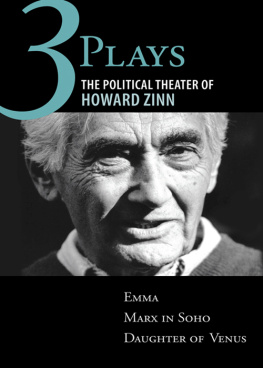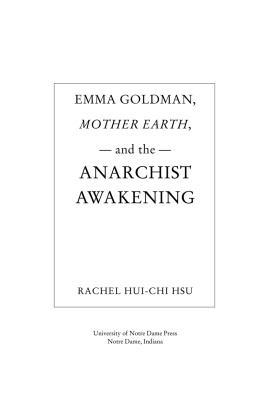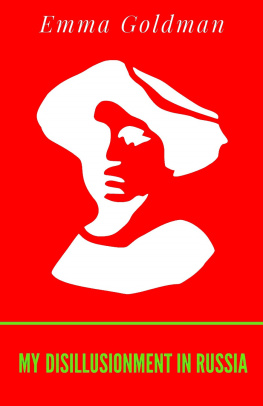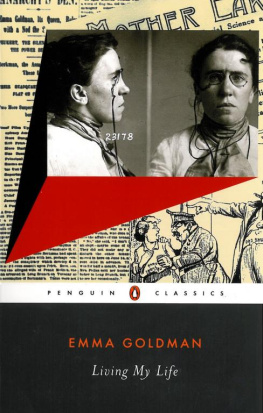EMMA GOLDMAN

Emma Goldman
Revolution as a Way of Life
VIVIAN GORNICK

Published with assistance from the Louis Stern Memorial Fund.
Copyright 2011 by Vivian Gornick.
All rights reserved.
This book may not be reproduced, in whole or in part, including illustrations, in any form (beyond that copying permitted by Sections 107 and 108 of the U.S. Copyright Law and except by reviewers for the public press), without written permission from the publishers.
Yale University Press books may be purchased in quantity for educational, business, or promotional use. For information, please e-mail sales.press@yale.edu (U.S. office) or sales@yaleup.co.uk (U.K. office).
Set in Janson Oldstyle type by Tseng information Systems, inc.
Printed in the United States of America by Sheridan Books,
Ann Arbor, Michigan.
Library of Congress cataloging-in-Publication Data
Gornick, Vivian.
Emma Goldman: revolution as a way of life / Vivian Gornick.
p. cm.
Includes bibliographical references and indereferences and index.
ISBN 978-0-300-13726-2 (alk. paper)
1. Goldman, Emma, 18691940. 2. Women anarchists
United StatesBiography. I. Title.
HX843.7.G65G67 2011
335.83092dc22
[B]
2011007549
A catalogue record for this book is available from the British Library.
This paper meets the requirements of ANSI/NISO Z39.48-1992
(Permanence of Paper).
10 9 8 7 6 5 4 3 2 1
Frontispiece: Emma Goldman writing at her desk, ca. 1910. American
Pictorial Collection, Hoover Institution Archives, Stanford University.
CONTENTS
Part I
Temperament
A HANDFUL OF RADICALS throughout the centuries have intuited that a successful revolution includes a healthy passion for the inner life. One of them was the anarchist Emma Goldman. The right to stay alive in ones senses, and to live in a world that prized that aliveness, was, for her, a key demand in any struggle she cared to wage against coercive government rule. The hatred she bore the centralized state was rooted in what she took to be governments brutish contempt for the feeling life of the individual. Fellow radicals who exhibited a similar contempt were to be held to the same standard. Comrades were those who, in the name of the revolution, were bent on honoring the complete human being.
Although Mikhail Bakunin, that fiercest of Russian anarchists, was one of her heroes, his famous definition of the revolutionary as a man who has no interests of his own, no feelings, no habits, no longings, not even a name, only a single interest, a single thought, a single passionthe revolution was as abhorrent to Goldman as corporate capitalism. If revolutionaries gave up sex and art while they were making the revolution, she said, they would become devoid of joy. Without joy, human beings cease being human. Should the men and women who subscribed to Bakunins credo prevail, the world would be even more heartless after the revolution than it had been before.
The conviction that revolution and the life of the senses dare not be mutually exclusive made Goldman eloquent in defense of causessexual freedom, birth control, marriage reformthat a majority of her fellow anarchists derided as trivializing the Cause; the comrades repeatedly took her to task for, as many of them said, interpreting anarchism as a movement for individual self-expression rather than a revolution of the collective. Hotly, she defended her need to define anarchism as she experienced it, with or without radical consensus. After all, what good was a revolution if at the end of the day one couldnt speak ones mind freely? To retreat from this insight, she insisted, was to ensure political disaster. And, indeed, after the party of Lenin came to power in 1917declaring the proletariat glorious, the intelligentsia contemptible, and any who said otherwise an enemy of the peopleshe knew that the Russian Revolution was lost. When she said so in Moscow in 1921, she was promptly invited to leaveexactly as she had been in the United States in 1919 after years of challenging the American democracy on much the same grounds. Keeping her company in one state of exile after another was the daily reminderto herself and all who would listenthat the right to think and speak freely had always been the first article of faith nailed to Emma Goldmans front door.
It was the intensity with which she declared herselfin lecture halls, on open-air platforms, in school auditoriums and private homes, from theater stages and prison cells, the back of a truck or a courtroom standthat made her world famous. That intensity, her signature trait, was midwife to a remarkable gift she had for making those who heard her feel intimately connected to the pain inherent in whatever social condition she was denouncing. As the women and men in her audience listened to her, a scenario of almost mythic proportions seemed to unfold before their eyes. The homeliness of their own small lives became invested with a sense of drama that acted as a catalyst for the wild, vagrant hopeespecially vulnerable to mean-spirited timesthat things need not be as they are.
This ability to make vivid the distress of living under the arbitrary rule of institutional powerGoldmans eternal subject, no matter what the title of the lectureoriginated in an ingrained sense of oppression that burned as brightly in her at the end of her earthly existence as it did at the beginning. The story of her life, as she told it, set against a background of Russian despotism, Jewish marginality, and filial lovelessness, was one long tale of protest, not so much against poverty and discrimination (although there was plenty of that), as against a perception, there from earliest times, that some inborn right to begin and end with herself was forever being thwarted. There seemed always to be those in a position of authority to exercise restraint unfairly, and for no real reason over those who were not free to throw it off. She had always felt the situation as puzzling and unjust; and in her, such was her disposition, that injustice burned unbearably. It was the unbearably that set her apart.
In short: Emma Goldman was a born refusenik. Dont tell me what to do! must have been the first sentence out of her mouth. An anecdote made famous in the 1970s when Goldmans iconic status was being revived says much on this score. One night when she was young, she was dancing madly at an anarchist party when a puritanical comrade urged her to stop, insisting that her frivolity was hurting the Cause. On the instant, Emma flew into a rage, stamped her feet, and told him to mind his own damned business. If I cant dance, her response has been paraphrased, Im not coming to your revolution. The tale is told as a tribute to the emblematic boldness with which she defended her righteveryones rightto pleasure, but it could just as easily have concentrated on the startling extremity with which she balked at restraint and swiftly felt hot defiance boiling up inside her.
Felt is the operative word. She always claimed that the ideas of anarchism were of secondary use if grasped only with ones reasoning intelligence; it was necessary to feel them in every fiber like a flame, a consuming fever, an elemental passion. This, in essence, was the core of Goldmans radicalism: an impassioned faith, lodged in the nervous system, that feelings were everything. Radical politics for her was, in fact, the history of ones own hurt, thwarted, humiliated feelings at the hands of institutionalized authority. Handed down from on high, such authority was to be fought at all times, in all places, with all ones might. From this single-minded simplicityone that neither gained nuance nor lost forceshe never departed. It was, in her, a piece of inspired arrest.
Next page









